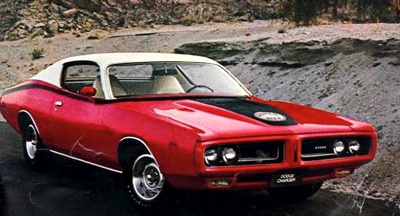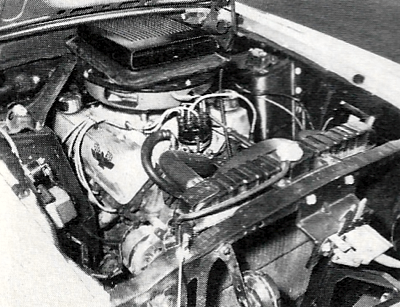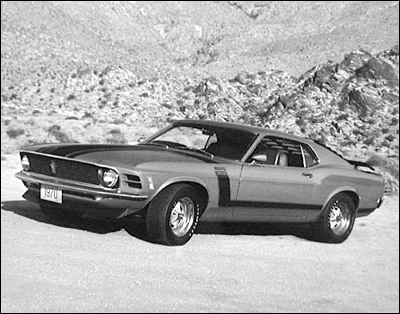|
American Muscle Cars of 1970
|
Country: |
 |
|
If there was a time when everything came into focus in the horsepower wars, it was the census year of
1970. Besides inflation, pollution, a down stock market, labor strikes, the generation gap, crime, the Vietnam war, horrible traffic and cyclamates, the auto industry was also running scared. It knew the noose was about to tighten in the emissions arena, where performance was fast becoming a dirty word.
The insurance companies were doing their part to put the lid on power. Rates were rising like the Mississippi after a spring thaw. Many who had planned to purchase a new muscle machine had second thoughts once they discussed the purchase with their insurance agents. But the lid wasn't closed quite yet. Dodge and Plymouth introduced their first true "ponycars" to run up against the likes of the Mustang and Camaro.
Long overdue but, as they say, better late than never. Slightly bigger and heavier than their competitors, they still managed to feature the long hood and short rear deck that characterized the market. The E-bodies were really shortened B-body platforms, which had the advantage of allowing any Mopar
engine to fit between the frame-rails.
So the ‘Cuda and Challenger could be ordered with a 340 small-block, 383 B-block, 440 Magnum, 440 Six-Pack orthe awesome 426 Street Hemi. The major difference between the two models, besides sheetmetal, was a 2-inch longer wheelbase on the Dodge version. The big change in the
Hemi that year was the switch to a hydraulic cam and lifters, eliminating the need for constant valve maintenance. This helped ensure that
engine tune would remain more consistent. And they ran like the wind, bolted up to the heavy duty 4-speed or tough TorqueFlite. Rear axle choice included the venerable 83/4 or the 93/4 Dana 60 carriers.
Trans-Am racing was getting bigger by the year, and the Mopar gang didn't care to be left out. So, for 1970, .they came up with two Trans-Am-inspired packages, the Challenger T/A and 'Cuda AAR, both taking advantage of the new ruling allowing racers to destroke an existing powerplant rather than develop a special 5.0-liter mill. So the 340 Six-Pack was born, a beefy
engine nestled in a chassis that really handled. AAR stood for All American Racer, the name of Dan Gurney's racing operation, which played a major role in the car's development. T/A, of course, stood for Trans-Am. Chrysler's "little" musclecars included the Duster and Swinger 340s, powerful A-body machines with swoopy, semi-fastback rooflines. The Swinger name was pretty lame, but the car certainly wasn't.
Chevys had it pretty good that year. The new 454s supplanted the 427s, potentially the strongest combinations out of Detroit. But the engineers frittered it away when they dropped all their hi-riser intake manifolds to get lower hood lines for styling purposes. The "low-riser" replacements, with their sharper turns and smaller plenums, more than offset the gains coming from the extra cubic inches. So the fabled 454 LS6
engine of
1970 was only a little stronger on the top end than the 427 L72 of '69, despite its advertised horsepower rating of 450 at 5600 rpm. One thing that the LS6 had was torque. In the 1970 Chevelle SS 454 package, a tap on the loud pedal and you were buried in your seat for as long as you held your foot down.
A popular new option for the Chevelles was the ZR2 Cowl Induction hood. This is the one with the little vacuum-operated trap door at the back edge of the hump. It popped open when you punched the throttle and let cold air from the base of the windshield into the carb filter housing. Quite effective and a great show-off gimmick for the drive-in crowd. Astrology was a new fad, but few predicted that Pete Hamilton would win the Daytona 500 in a Plymouth and
Jochen Rindt of Austria would be crowned the World Driving Champion posthumously.

1970 Dodge Charger Super Bee.
 The lightweight Torino Cobra packed a 429 Cobra Jet V8 - which made it arguably more potent that a 428 CJ Mustang.
The lightweight Torino Cobra packed a 429 Cobra Jet V8 - which made it arguably more potent that a 428 CJ Mustang.
 1970 Ford Mustang Boss 302.
1970 Ford Mustang Boss 302.
 1970 Z28 - but we didn't need to tell you that.
1970 Z28 - but we didn't need to tell you that.
|
Al Unser took the first of his four Indy 500 victories and also captured the US AC driver's title. Gary Gabelich set a new world speed record of 622.407 in the Blue Flame and the Le Mans 24-hour epic was won by the Herrmann/Attwood Porsche 917K. Pro Stock was a popular new NHRA drag racing class that gained instant notoriety among the fans.
The popular Camaro line received a whole new body and chassis and I could be had with any number of I 39-6 engines, as well as a Corvette inspired 350 LTl. This was a solid ft low to mid-14-second machine and could easily run with many big-blocks of the day. Camaros were also known for their handling, especially with the new chassis of the '70 model year. This, coupled with the new SCC A rules allowing 350 small-blocks instead of the former 302
engine, made for a great Z/28. The LTl was the peak of small-block development, a free revving, torquey little sweetheart.
An LS6 Camaro package was listed, but it is questionable whether or not any made it to production. Even Corvettes had a late start, for none were produced until February of the year, making it the lowest number of Vettes produced (17,316) since 1962. But the LTl option was the first solid-lifter small-block available since 1965, rated at 370 hp. Only 1287 were built. Other Corvette
engine options included the L46 350/350, LS5 390/454 and LS7 460/454, the latter never making it into any production Vettes. But the LS7 aluminium-block engines found their way into many Can-Am cars of the day, such as the awesome McLarens.
AMC came out with a GTO-inspired intermediate called the Rebel, with specialised graphics and a 340-hp, 390-cube engine. The man behind the project was none other than Jim Wangers, famous for his Pontiac escapades and a big supporter of the original GTO program. This would also be the last year for the two-seater AMX, a car that proved less than popular with performance-oriented drivers.
Buick introduced its famous Stage 1 performance package for the Gran Sport (GNS) line in 1969. But it took the big 455 block in 1970 to really make it come to life. The kit included a hot hydraulic camshaft, limited-slip differential, dual exhaust and optional hood air scoops. Even with 4000 pounds of bulk, the car was capable of low 14-second quarters at nearly 100 mph. You couldn't buy more stock performance than a Hemi.
Even though it was never offered as a special option package, either RPO or dealer-installed, we should mention the handful of Stage II 455s that somehow slipped out the back door in 1970. These used most of the Stage I stuff, but special cylinder heads were cast with re-contoured intake ports, huge round exhaust ports, an Edelbrock hi-rise manifold on which a big Holley 780-cfm carb rested and a set of handmade tubular headers. This combo had awesome performance - low 13s at over 103 mph - but Buick never followed through with even limited production. Various reasons have been heard through the years.
Some say the head castings were flawed and cracked, others say Buick didn't want to tool up special exhaust manifolds to match the round ports and didn't want to use tubular headers on a factory car because of noise standards. Only a handful of the cars ever saw the light of day. Over at Ford, there was a variety of high performance street combinations for 1970, almost to the point of buyer confusion. There was no real way to know what would be the best combination for the stoplight grand prix.
In the Mustang line, for example, you had the Boss 302 and Boss 429 models introduced the prior year. They were a known quantity. Less known was the Cobra Jet 428, with 4-speed or C-6 automatic, a strong, flexible street engine with lots of goodies. You could also order a "Super" version of the package, which included a hot solid-lifter valve-train, forged pistons, four-bolt mains and an oil cooler. Face it, a well-tuned 428 CJ was a match for a Boss 429.
The serious Ford aficionado also had to decide about a 1970 Torino Cobra with a 429 Cobra Jet engine - an entirely different engine from the 428 CJ. This is the basic Limabig-block V8, as opposed to the FE engine used for the 428, and it has staggered valves with ball-joint rockers, much bigger ports and valves and a state-of-the-art bottom end. It was a more potent street combination than a 428 Mustang, especially when you consider the relatively light weight of the Torino coupe. There was even a new 351 Cleveland small-block Mustang and Torino. This was designed like a scaled-down Lima 429 and it had many attributes that made it a great engine. It's never been recognized as it should've been.
Olds went to its 455 in the 4-4-2 line. And the optional W30 version seemed to get a special boost. The famous vacuum-cleaner scoops were changed to large dual hood scoops feeding a sealed air cleaner through a vacuum-operated flap valve. This only opened at full throttle, so the engine could breathe warm under-hood air while cruising. This was a necessity on high performance cars by 1970, because emissions regulations required lean part-throttle carburetion that would cause stumbling and hesitation on very cold air. There was no doubt that the 455 W30s were wild performers, although they were usually sold to a more "mature" buyer. The W31 package introduced in '69 continued in a wild new Rallye 350 model, painted bright Sebring Yellow - including the bumpers and wheels - with red and black striping and a big rear-deck spoiler. It was a real attention grabber!
Little was new in the Pontiac camp. Its top performance engine for both GTOs and Firebirds was the 400-cube Ram Air IV carried over from '69. One reason they didn't do more for the 1970 models is that they had planned to release a lot of Trans-Am race equipment for the 400 block—tunnel-port heads, big manifold, hot cam, the whole bit—and call it the Ram Air V engine. When this program fell through, due to GM's policy of simplifying option packages, Pontiac was left with not much new, but that would be well taken care of in 1971.



